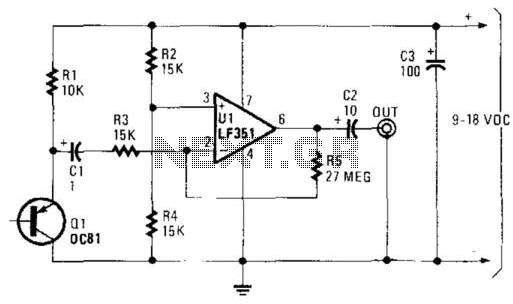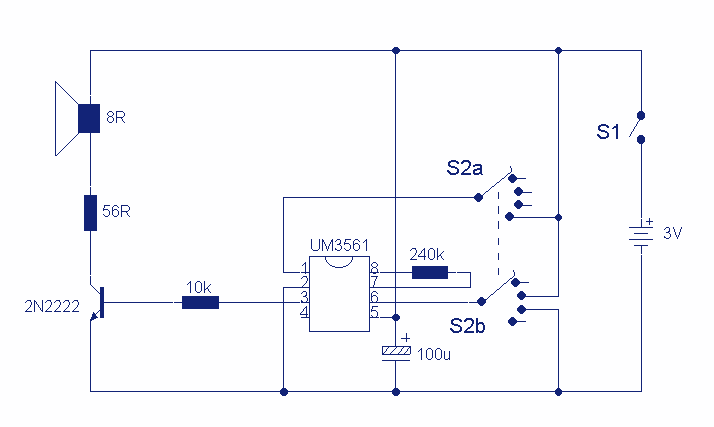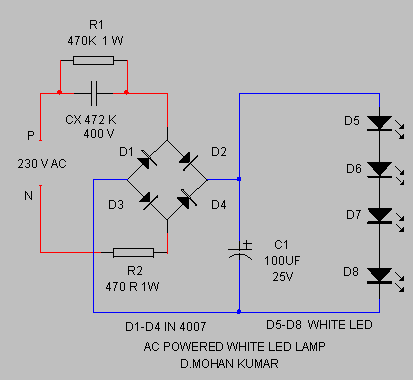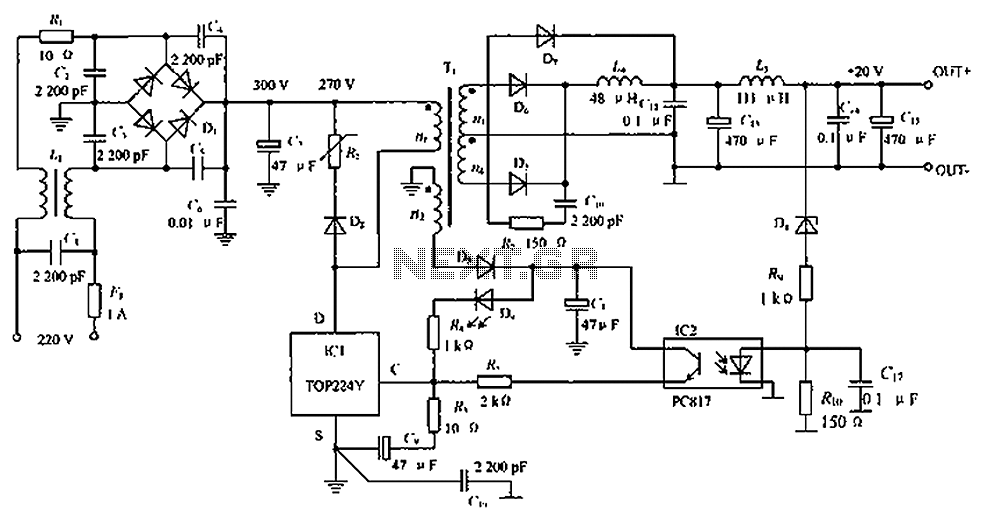
White Noise Generator

A germanium transistor (Ql) is utilized as a noise generator within the audio frequency range. The operational amplifier (Ul) serves as a high-gain amplifier. The specific characteristics of Ql are not critical; most germanium transistors are generally effective for this application. Additionally, a germanium diode may serve as a suitable substitute. This circuit is primarily designed for sound effects and noise experimentation. It does not provide a flat response across the audio range due to the inherent variability in Ql, but it remains adequate for applications where high precision is not a requirement.
The circuit employs a germanium transistor as the core noise generation component, which exploits the inherent noise characteristics of germanium-based devices. The transistor operates in its active region, generating a wide spectrum of noise that can be amplified by the operational amplifier (Ul). The choice of a germanium transistor is significant due to its favorable noise performance compared to silicon transistors, particularly in low-frequency applications.
The high-gain amplifier (Ul) is configured to amplify the noise signal produced by Ql, allowing it to be used effectively in sound synthesis or experimental setups. The gain of Ul can be adjusted through feedback resistors, enabling fine-tuning of the output level to suit various applications. The circuit's design accommodates the substitution of a germanium diode, which can also contribute to noise generation while simplifying the circuit configuration.
While the circuit is not designed for precision audio applications, it is valuable for generating sound effects, testing audio equipment, and conducting experiments in audio signal processing. The non-flat response across the audio range is a characteristic of the noise generation process, influenced by the transistor's characteristics and external circuit elements. Users should expect variability in the output noise characteristics, making this circuit suitable for creative applications rather than precise audio reproduction. Germanium transistor Ql is used as a noise generator in the audio range. Ul acts as a high-gain amplifier. Ql is not critical; most germanium transistors appear to be satisfactory. A germanium diode can also be substituted. This circuit is mainly used for sound effects and noise experiments. It is not flat over the audio range because of unpredictable effects in Ql, but it should be useful where high precision is not necessary.
The circuit employs a germanium transistor as the core noise generation component, which exploits the inherent noise characteristics of germanium-based devices. The transistor operates in its active region, generating a wide spectrum of noise that can be amplified by the operational amplifier (Ul). The choice of a germanium transistor is significant due to its favorable noise performance compared to silicon transistors, particularly in low-frequency applications.
The high-gain amplifier (Ul) is configured to amplify the noise signal produced by Ql, allowing it to be used effectively in sound synthesis or experimental setups. The gain of Ul can be adjusted through feedback resistors, enabling fine-tuning of the output level to suit various applications. The circuit's design accommodates the substitution of a germanium diode, which can also contribute to noise generation while simplifying the circuit configuration.
While the circuit is not designed for precision audio applications, it is valuable for generating sound effects, testing audio equipment, and conducting experiments in audio signal processing. The non-flat response across the audio range is a characteristic of the noise generation process, influenced by the transistor's characteristics and external circuit elements. Users should expect variability in the output noise characteristics, making this circuit suitable for creative applications rather than precise audio reproduction. Germanium transistor Ql is used as a noise generator in the audio range. Ul acts as a high-gain amplifier. Ql is not critical; most germanium transistors appear to be satisfactory. A germanium diode can also be substituted. This circuit is mainly used for sound effects and noise experiments. It is not flat over the audio range because of unpredictable effects in Ql, but it should be useful where high precision is not necessary.





